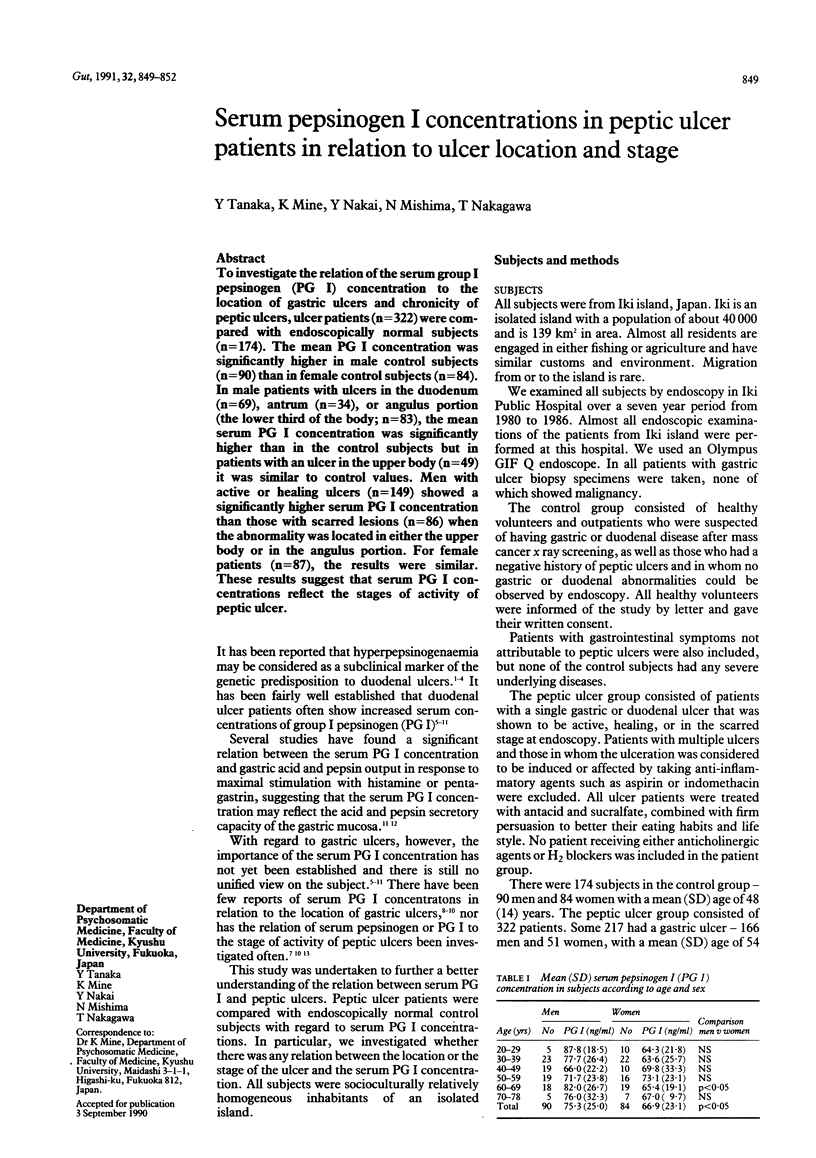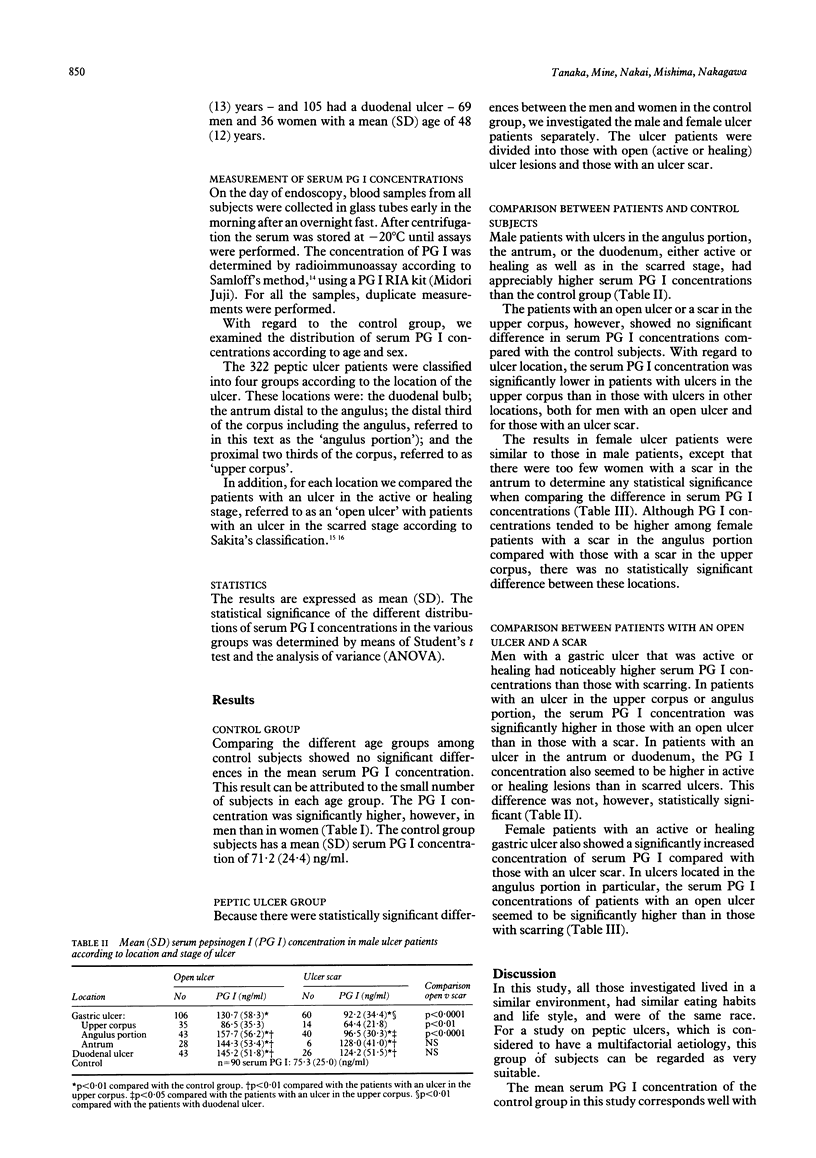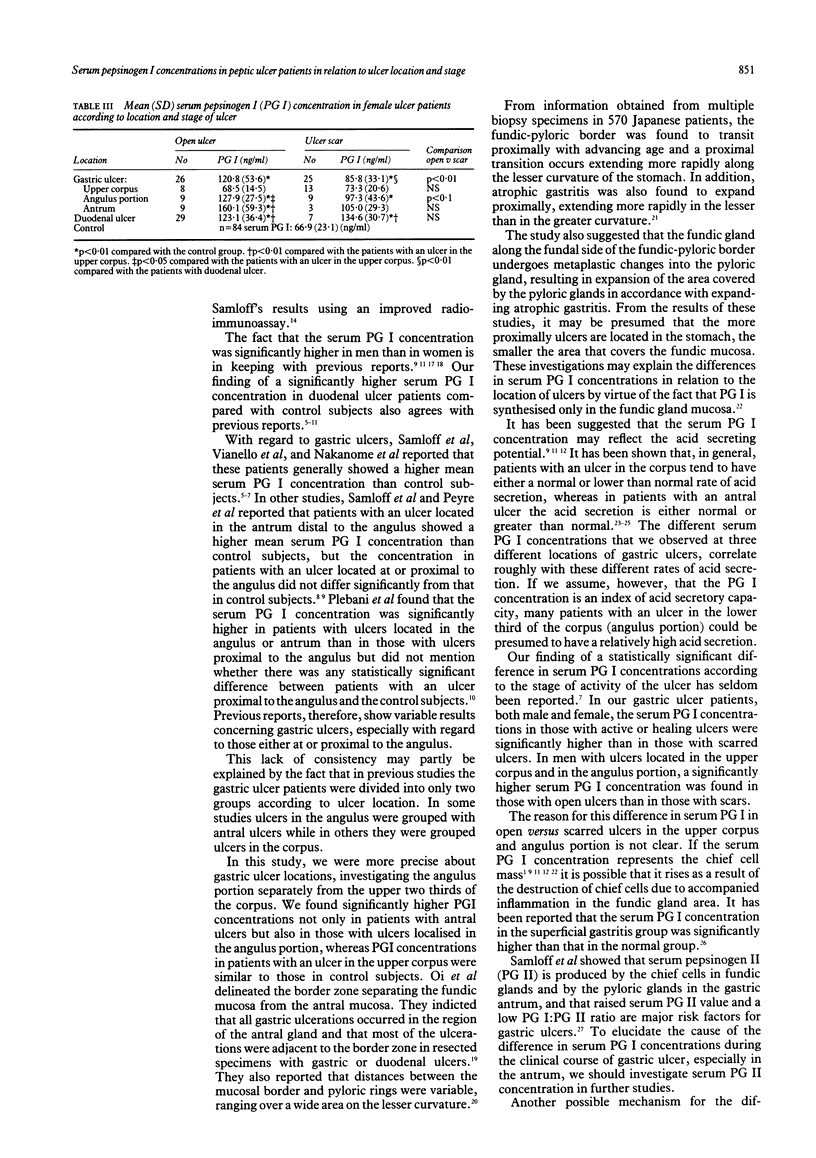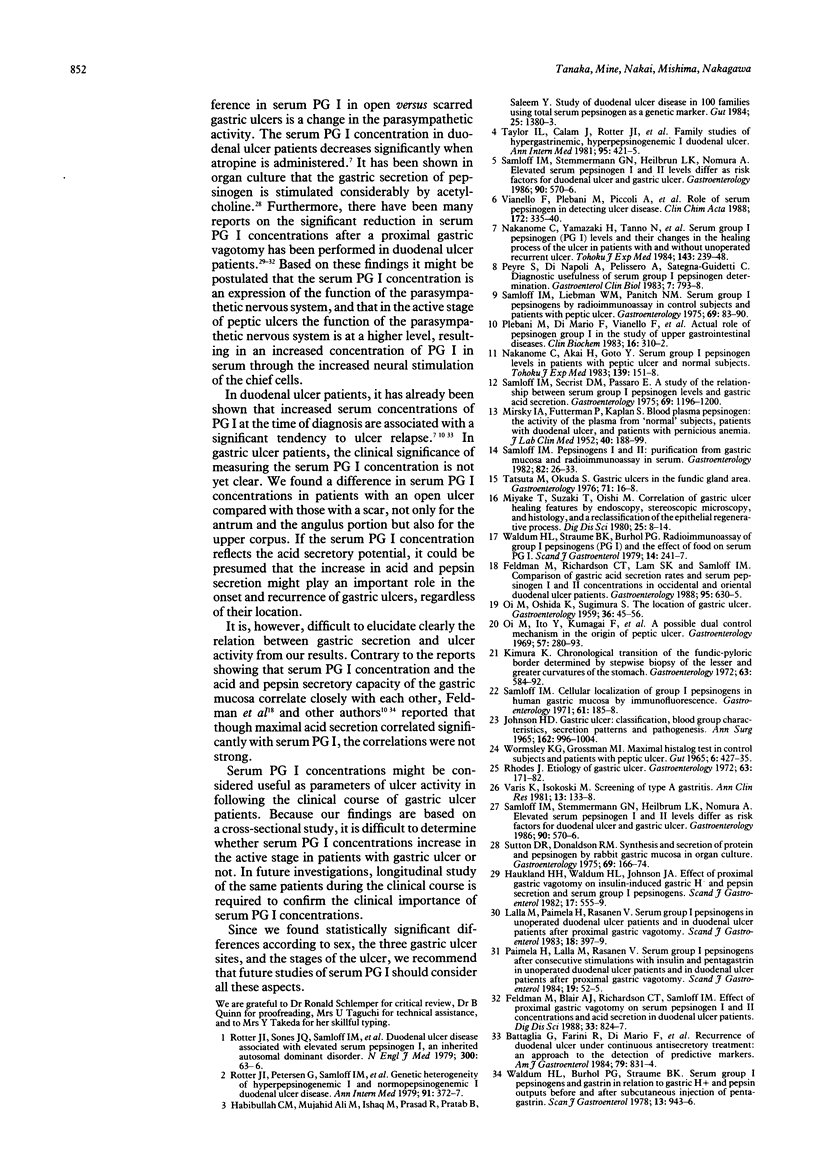Abstract
To investigate the relation of the serum group I pepsinogen (PG I) concentration to the location of gastric ulcers and chronicity of peptic ulcers, ulcer patients (n = 322) were compared with endoscopically normal subjects (n = 174). The mean PG I concentration was significantly higher in male control subjects (n = 90) than in female control subjects (n = 84). In male patients with ulcers in the duodenum (n = 69), antrum (n = 34), or angulus portion (the lower third of the body; n = 83), the mean serum PG I concentration was significantly higher than in the control subjects but in patients with an ulcer in the upper body (n = 49) it was similar to control values. Men with active or healing ulcers (n = 149) showed a significantly higher serum PG I concentration than those with scarred lesions (n = 86) when the abnormality was located in either the upper body or in the angulus portion. For female patients (n = 87), the results were similar. These results suggest that serum PG I concentrations reflect the stages of activity of peptic ulcer.
Full text
PDF



Selected References
These references are in PubMed. This may not be the complete list of references from this article.
- Battaglia G., Farini R., Di Mario F., Piccoli A., Plebani M., Vianello F., Burlina A., Naccarato R. Recurrence of duodenal ulcer under continuous antisecretory treatment: an approach to the detection of predictive markers. Am J Gastroenterol. 1984 Nov;79(11):831–834. [PubMed] [Google Scholar]
- Feldman M., Blair A. J., 3rd, Richardson C. T., Samloff I. M. Effect of proximal gastric vagotomy on serum pepsinogen I and II concentrations and acid secretion in duodenal ulcer patients. Dig Dis Sci. 1988 Jul;33(7):824–827. doi: 10.1007/BF01550970. [DOI] [PubMed] [Google Scholar]
- Feldman M., Richardson C. T., Lam S. K., Samloff I. M. Comparison of gastric acid secretion rates and serum pepsinogen I and II concentrations in Occidental and Oriental duodenal ulcer patients. Gastroenterology. 1988 Sep;95(3):630–635. doi: 10.1016/s0016-5085(88)80008-8. [DOI] [PubMed] [Google Scholar]
- Habibullah C. M., Mujahid Ali M., Ishaq M., Prasad R., Pratap B., Saleem Y. Study of duodenal ulcer disease in 100 families using total serum pepsinogen as a genetic marker. Gut. 1984 Dec;25(12):1380–1383. doi: 10.1136/gut.25.12.1380. [DOI] [PMC free article] [PubMed] [Google Scholar]
- Haukland H. H., Waldum H. L., Johnson J. A. Effect of proximal gastric vagotomy on insulin- induced gastric H+ and pepsin secretion and serum group I pepsinogens. Scand J Gastroenterol. 1982 Jun;17(4):555–559. doi: 10.3109/00365528209182249. [DOI] [PubMed] [Google Scholar]
- Johnson H. D. Gastric ulcer: classification, blood group characteristics, secretion patterns and pathogenesis. Ann Surg. 1965 Dec;162(6):996–1004. doi: 10.1097/00000658-196512000-00005. [DOI] [PMC free article] [PubMed] [Google Scholar]
- Kimura K. Chronological transition of the fundic-pyloric border determined by stepwise biopsy of the lesser and greater curvatures of the stomach. Gastroenterology. 1972 Oct;63(4):584–592. [PubMed] [Google Scholar]
- Lalla M., Paimela H., Räsänen V. Serum group I pepsinogens in unoperated duodenal ulcer patients and in duodenal ulcer patients after proximal gastric vagotomy. Scand J Gastroenterol. 1983 May;18(3):397–399. doi: 10.3109/00365528309181613. [DOI] [PubMed] [Google Scholar]
- MIRSKY A., FUTTERMAN P., KAPLAN S. Blood plasma pepsinogen. II. The activity of the plasma from normal subjects, patients with duodenal ulcer, and patients with pernicious anemia. J Lab Clin Med. 1952 Aug;40(2):188–199. [PubMed] [Google Scholar]
- Miyake T., Suzaki T., Oishi M. Correlation of gastric ulcer healing features by endoscopy, stereoscopic microscopy, and histology, and a reclassification of the epithelial regenerative process. Dig Dis Sci. 1980 Jan;25(1):8–14. doi: 10.1007/BF01312726. [DOI] [PubMed] [Google Scholar]
- Nakanome C., Yamazaki H., Tanno N., Sasaki M., Sato W., Hanada M., Moriai N., Komatsu K. Serum group I pepsinogen (PG I) levels and their changes in the healing process of the ulcer in patients with and without unoperated recurrent ulcer. Tohoku J Exp Med. 1984 Jun;143(2):239–248. doi: 10.1620/tjem.143.239. [DOI] [PubMed] [Google Scholar]
- OI M., OSHIDA K., SUGIMURA S. The location of gastric ulcer. Gastroenterology. 1959 Jan;36(1):45–56. [PubMed] [Google Scholar]
- Oi M., Ito Y., Kumagai F., Yoshida K., Tanaka Y., Yoshikawa K., Miho O., Kijima M. A possible dual control mechanism in the origin of peptic ulcer. A study on ulcer location as affected by mucosa and musculature. Gastroenterology. 1969 Sep;57(3):280–293. [PubMed] [Google Scholar]
- Paimela H., Lalla M., Räsänen V. Serum group I pepsinogens after consecutive stimulations with insulin and pentagastrin in unoperated duodenal ulcer patients and in duodenal ulcer patients after proximal gastric vagotomy. Scand J Gastroenterol. 1984 Jan;19(1):52–55. [PubMed] [Google Scholar]
- Peyre S., Di Napoli A., Pelissero A., Sategna-Guidetti C. Diagnostic usefulness of serum group I pepsinogen determination. Gastroenterol Clin Biol. 1983 Oct;7(10):793–798. [PubMed] [Google Scholar]
- Plebani M., Di Mario F., Vianello F., Farini R., Piccoli A., Lazzaretto L., Perobelli L., Naccarato R., Burlina A. Actual role of pepsinogen group I in the study of upper gastrointestinal diseases. Clin Biochem. 1983 Oct;16(5):310–312. doi: 10.1016/s0009-9120(83)94151-6. [DOI] [PubMed] [Google Scholar]
- Rhodes J. Etiology of gastric ulcer. Gastroenterology. 1972 Jul;63(1):171–182. [PubMed] [Google Scholar]
- Rotter J. I., Petersen G., Samloff I. M., McConnell R. B., Ellis A., Spence M. A., Rimoin D. L. Genetic heterogeneity of hyperpepsinogenemic I and normopepsinogenemic I duodenal ulcer disease. Ann Intern Med. 1979 Sep;91(3):372–377. doi: 10.7326/0003-4819-91-3-372. [DOI] [PubMed] [Google Scholar]
- Rotter J. I., Sones J. Q., Samloff I. M., Richardson C. T., Gursky J. M., Walsh J. H., Rimoin D. L. Duodenal-ulcer disease associated with elevated serum pepsinogen I: an inherited autosomal dominant disorder. N Engl J Med. 1979 Jan 11;300(2):63–66. doi: 10.1056/NEJM197901113000203. [DOI] [PubMed] [Google Scholar]
- Samloff I. M. Cellular localization of group I pepsinogens in human gastric mucosa by immunofluorescence. Gastroenterology. 1971 Aug;61(2):185–188. [PubMed] [Google Scholar]
- Samloff I. M., Liebman W. M., Panitch N. M. Serum group I pepsinogens by radioimmunoassay in control subjects and patients with peptic ulcer. Gastroenterology. 1975 Jul;69(1):83–90. [PubMed] [Google Scholar]
- Samloff I. M. Pepsinogens I and II: purification from gastric mucosa and radioimmunoassay in serum. Gastroenterology. 1982 Jan;82(1):26–33. [PubMed] [Google Scholar]
- Samloff I. M., Secrist D. M., Passaro E., Jr A study of the relationship between serum group I pepsinogen levels and gastric acid secretion. Gastroenterology. 1975 Dec;69(6):1196–1200. [PubMed] [Google Scholar]
- Samloff I. M., Stemmermann G. N., Heilbrun L. K., Nomura A. Elevated serum pepsinogen I and II levels differ as risk factors for duodenal ulcer and gastric ulcer. Gastroenterology. 1986 Mar;90(3):570–576. doi: 10.1016/0016-5085(86)91110-8. [DOI] [PubMed] [Google Scholar]
- Samloff I. M., Stemmermann G. N., Heilbrun L. K., Nomura A. Elevated serum pepsinogen I and II levels differ as risk factors for duodenal ulcer and gastric ulcer. Gastroenterology. 1986 Mar;90(3):570–576. doi: 10.1016/0016-5085(86)91110-8. [DOI] [PubMed] [Google Scholar]
- Sutton D. R., Donaldson M., Jr Synthesis and secretion of protein and pepsinogen by rabbit gastric mucosa in organ culture. Gastroenterology. 1975 Jul;69(1):166–174. [PubMed] [Google Scholar]
- Tatsuta M., Okuda S. Gastric ulcers in the fundic gland area. Gastroenterology. 1976 Jul;71(1):16–18. [PubMed] [Google Scholar]
- Taylor I. L., Calam J., Rotter J. I., Vaillant C., Samloff I. M., Cook A., Simkin E., Dockray G. J. Family studies of hypergastrinemic, hyperpepsinogenemic I duodenal ulcer. Ann Intern Med. 1981 Oct;95(4):421–425. doi: 10.7326/0003-4819-95-4-421. [DOI] [PubMed] [Google Scholar]
- Varis K., Isokoski M. Screening of type A gastritis. Ann Clin Res. 1981 Jun;13(3):133–138. [PubMed] [Google Scholar]
- Vianello F., Plebani M., Piccoli A., Tessaro P., Di Mario F., Naccarato R., Burlina A. Role of serum pepsinogen in detecting ulcer disease. Clin Chim Acta. 1988 Mar 15;172(2-3):335–339. doi: 10.1016/0009-8981(88)90339-7. [DOI] [PubMed] [Google Scholar]
- Waldum H. L., Burhol P. G., Straume B. K. Serum group I pepsinogens and gastrin in relation to gastric H+ and pepsin outputs before and after subcutaneous injection of pentagastrin. Scand J Gastroenterol. 1978;13(8):943–946. doi: 10.3109/00365527809181373. [DOI] [PubMed] [Google Scholar]
- Waldum H. L., Straume B. K., Burhol P. G. Radioimmunoassay of group I pepsinogens (PGI) and the effect of food on serum PGI. Scand J Gastroenterol. 1979;14(2):241–247. doi: 10.3109/00365527909179877. [DOI] [PubMed] [Google Scholar]
- Wormsley K. G., Grossman M. I. Maximal histalog test in control subjects and patients with peptic ulcer. Gut. 1965 Oct;6(5):427–435. doi: 10.1136/gut.6.5.427. [DOI] [PMC free article] [PubMed] [Google Scholar]


